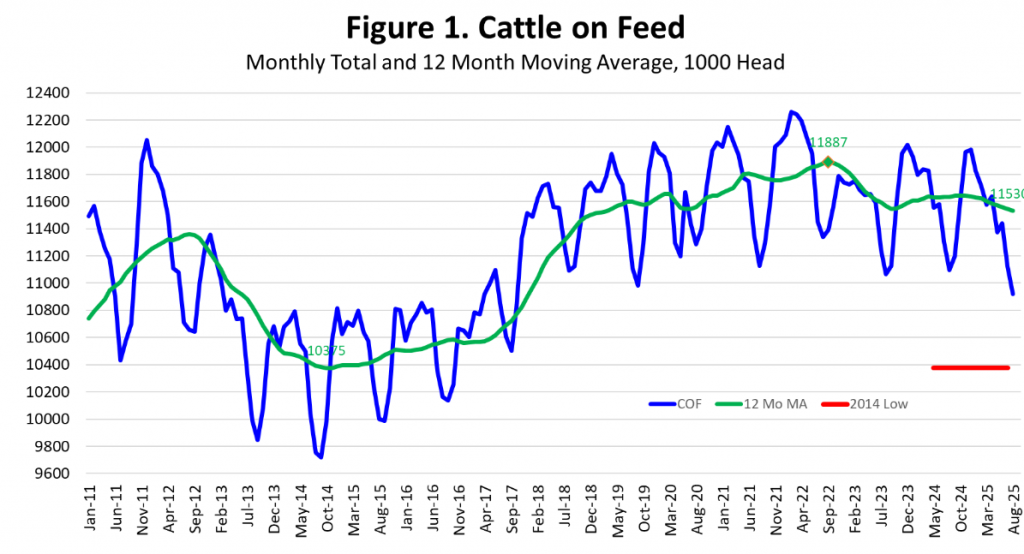
Dr. Derrell Peel, Oklahoma State University Extension Livestock Marketing Specialist, offers his economic analysis of the beef cattle industry as part of the weekly series known as the “Cow Calf Corner,” published electronically by Dr. Peel, Mark Johnson, and Paul Beck. Today, Dr. Peel discusses feed lot numbers.
The latest USDA-NASS Cattle on Feed report shows August 1 feedlot inventories at 10.922 million head, down 1.6 percent year over year. This is the eighth consecutive smaller monthly inventory and is the smallest monthly feedlot total since October 2017 (Figure 1). The 12-month moving average of feedlot inventories, which removes seasonality and shows general trends, dropped in August to the lowest level since March 2019.
July feedlot placements were slightly larger than expected, likely reflecting early sales of “fall-run” calves in response to ever-higher feeder cattle prices. Feeder cattle volumes in Oklahoma auctions are up 27.2 percent year over year in the past six weeks. Higher than expected placements occurred despite the lack of Mexican cattle imports. Texas placements were down 25 percent year over year; a 95,000 head reduction compared to one year ago. Total feedlot placements in July were down 104,000 head, meaning that the decrease in Texas accounts for over 91 percent of the total decline in monthly placements. July feedlot marketings were about as expected at 94 percent of last year.
The latest release of monthly livestock slaughter from USDA-NASS shows that beef production in July was down 4.5 percent year over year, contributing to a year-to-date decrease of 2.7 percent for the first seven months of 2025. Total cattle slaughter thus far in 2025 is down 5.8 percent, including a 4.2 percent decrease in fed (steer + heifer) slaughter and a 12.5 percent decrease in cow slaughter for the first seven months of the year.
Canada Update
The Canadian statistical agency, Statistics Canada, released July livestock inventories last week. The total cattle inventory is 11.9 million head, up 0.8 percent and the first increase since 2021. After declining for several years, the beef cow herd in Canada increased by 0.4 percent and beef replacement heifers were up 2.0 percent year over year. It appears that some herd rebuilding is beginning in Canada. Cattle on-feed in Alberta and Saskatchewan for August 1 are down 0.4 percent year over year at 777 thousand head.
Australia Too!
Cattle inventories in Australia have been increasing since 2021 to current levels just over 27 million head. The latest quarterly reports show cattle on feed in Australia at a new record level of 1.6 million head. Cattle feeding in Australia has increased four-fold in the past 30 years and continues to grow. Grain-fed beef currently accounts for 29 percent of total beef exports from Australia.

















